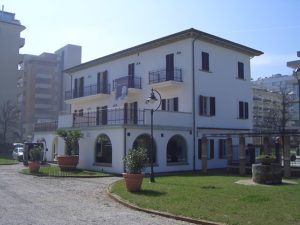A photography exhibition in northern Italy is drawing criticism over the location where it is being staged.
Riccione, a seaside town right outside Rimini, is hosting a retrospective on Robert Capa, one of the most significant photographers of the twentieth century. Featured, are over a hundred photographs between 1936 and his death in 1954. Capa, born Endre Ernő Friedmann, was on the run for much of his early life. He was born in Budapest, but had to flee Hungary at the age of 18 when accusations of being a communist sympathizer emerged. After spending a few years in Berlin, Friedmann had to escape to Paris when the Nazis came to power since he was Jewish. In Paris, he met a German Jewish photojournalist named Gerta Pohorylla. Together, they published photographs under the name Capa. However, when Pohorylla began working under the name Gerda Taro, Friedmann took the Capa name for himself. Capa soon became a renowned war photographer, documenting multiple conflicts, including the Spanish Civil War, the Second World War, and the First Indochina War. However, he also captured moments from the daily lives of the twentieth century’s most iconic figures, including Pablo Picasso and Françoise Gilot, Gary Cooper, Ingrid Bergman and Alfred Hitchcock, and Henri Matisse. He even became close personal friends with Ernest Hemingway and John Steinbeck.
The controversy surrounding the current Capa retrospective predates the exhibition since it’s more about its location rather than the contents. Riccione chose to host the exhibition at the Villa Mussolini. The three-story building was, evidently, Benito Mussolini’s summer residence, purchased by his wife Rachele in 1934. However, no one ever called it the Villa Mussolini while the fascist dictator resided there. If it had a name at all, it was the Villa Margherita or the Villa Monti. At this location, Il Duce hosted guests and conducted government business for a decade. Because the villa was in Rachele’s name, it was not confiscated by the state after the war, allowing her to sell the property in 1952. In its post-war life, it was the site of a restaurant and then a veterinarian’s office, but it had been abandoned by the 1980s. In 1997, a local bank bought the building and loaned it to the town of Riccione. After a €1 million restoration, the building reopened in 2005 as the Villa Mussolini; a cultural events space. The name drew negative attention then, especially since the dictator’s youngest child, Romano Mussolini, attended the reopening.
The Robert Capa retrospective is just the latest instance of attention drawn to the building’s name. Many have noted that it seems inappropriate for the Villa Mussolini to host the work of a Jewish photographer, especially one who had to flee Berlin out of fear of fascist persecution. On the other hand, it also seems like an ironic act of justice. What better way to spite fascists than to use Mussolini’s villa to exhibit the work of a Jewish artist? And not just any Jewish artist; one who documented the struggle of antifascist Republicans during the Spanish Civil War, and who accompanied American soldiers sent to liberate France from fascist occupation. Giving the site this name so many decades removed from the trauma of the Second World War may have been a little insensitive. But perhaps there is a sort of poetic justice in displaying Capa’s photographs there. It could be likened to how the Allies chose Nuremberg, a city of such significance to the Nazis, as the place to host the trials of fascist war criminals. Il Duce likely would have hated it, and that’s more than enough for me.

